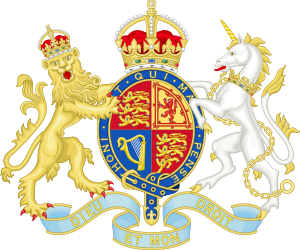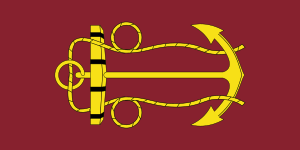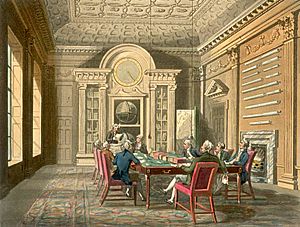Admiralty (United Kingdom) facts for kids

|
|
| Department overview | |
|---|---|
| Formed | 1707 |
| Preceding Department | |
| Dissolved | 1964 |
| Superseding agency |
|
| Jurisdiction | Government of the United Kingdom |
| Headquarters | War Office building Whitehall London |
| Department executive |
|
| Parent Department | HM Government |
The Admiralty was a very important department of the Government of the United Kingdom. It was in charge of the Royal Navy, which is the UK's navy, from 1707 until 1964.
Historically, the person in charge was called the Lord High Admiral of the United Kingdom. But for most of the Admiralty's history, this job was done by a group of people called the Lords Commissioner of the Admiralty. They worked together on the Board of Admiralty.
In 1964, the Admiralty was replaced by the Admiralty Board. This happened when the Ministry of Defence was created. Today, the Royal Navy is managed by a different group called the Navy Board. However, people still sometimes use 'The Admiralty' to refer to those in charge of the Royal Navy.
Before 1707, the "Office of the Admiralty and Marine Affairs" managed the Royal Navy of England. When England and Scotland joined to form Great Britain, the Admiralty took over the Scottish navy too. The Admiralty was very important because the Royal Navy helped Britain expand its power and build the British Empire around the world.
The title of Lord High Admiral was held by the monarch from 1964 to 2011. It was then given to Prince Philip, Duke of Edinburgh by Queen Elizabeth II. After his death in 2021, the title returned to the monarch. There are also honorary roles like Vice-Admiral of the United Kingdom and Rear-Admiral of the United Kingdom.
Contents
History of the Admiralty
The role of Admiral of England was created around the year 1400. Before that, there were admirals for specific sea areas. In 1546, King Henry VIII set up the Council of the Marine. This group later became known as the Navy Board. Its job was to handle the day-to-day running of the navy.
The Lord High Admiral was still in charge of the navy's operations. This system, with the Lord High Admiral for operations and the Navy Board for administration, lasted a long time.
In 1628, King Charles I decided to have a committee, the Board of Admiralty, manage the navy instead of a single Lord High Admiral. This committee system was used most of the time after 1709. The last person to be a single Lord High Admiral was the future King William IV in the early 1800s.
The Navy Board was responsible for things like money, shipbuilding, and keeping records. But this system was not always efficient. In 1832, Sir James Graham combined the Navy Board's jobs with those of the Board of Admiralty. This was meant to make things simpler, but it also led to more paperwork.
By 1860, naval technology was growing fast, especially with the use of steam power. However, for many years, the navy did not focus much on strategy or planning. Most of the talent went into technical studies.
A serious effort to improve naval management began in 1909 with the creation of the Admiralty Navy War Council. Then, in 1912, the Admiralty War Staff was formed. It had sections for operations, intelligence, and getting the navy ready for action. But many senior officers did not like the idea of a staff. This lack of good planning was seen during the Dardanelles campaign in World War I.
In 1916, Sir John Jellicoe reorganized the War Staff. It was not until 1917 that the Admiralty truly became a professional military staff. The "Admiralty War Staff" was renamed the "Admiralty Naval Staff". The head of this staff, the Chief of the Naval Staff, also became the First Sea Lord.
New roles like Deputy Chief of the Naval Staff and Assistant Chief of the Naval Staff were created. These important naval officers joined the Board of Admiralty. This meant that the naval staff had a direct say in how the navy was run. The Deputy Chief of Naval Staff managed fleet operations, while the Assistant Chief handled merchant ship movements and anti-submarine efforts.
In 1917, the Chief of Naval Staff (CNS) was given full control over Royal Navy operations. This meant the CNS could issue orders directly to the fleet.
Finally, in 1964, the Admiralty was abolished as a separate department. It was merged with the War Office (for the army) and the Air Ministry (for the air force) into the new Ministry of Defence. Within this new ministry, the Admiralty Board and a separate Navy Board now manage the Royal Navy.
How the Admiralty Was Organized
In the 20th century, the Admiralty Headquarters had four main parts:
- The Board of Admiralty: This group directed and controlled everything. It was led by a civilian government minister called the First Lord of the Admiralty. The most important naval adviser on the board was the First Sea Lord and Chief of Naval Staff.
- The Admiralty Naval Staff: This group advised the Board on strategy and planning. They helped decide where to send fleets and how to use naval resources. They also created policies for naval tactics and equipment.
- The Admiralty Departments: These departments provided the people, ships, aircraft, and supplies needed for the navy. Different Sea Lords were in charge of these departments.
- The Department of the Permanent Secretary: This department helped coordinate everything. It managed naval money, gave advice on policy, handled all official letters, and kept records.
Board of Admiralty
When the job of Lord High Admiral was done by a committee, it was called the Board of Admiralty. This Board included both naval officers (called Naval Lords or Sea Lords) and politicians (called Civil Lords). The leader of the Board was the First Lord of the Admiralty, who was a member of the government's top committee, the Cabinet. After 1806, the First Lord was always a civilian, while the professional head of the navy was the First Sea Lord.
Lords Commissioners of the Admiralty (1628–1964)
These were the people who made up the Board of Admiralty. They were a mix of politicians and experienced naval officers. Over time, more naval officers joined the Board.
Key Officials
- First Lord of the Admiralty: This was the government minister in charge of all naval matters.
- First Sea Lord and Chief of Naval Staff: This was the top naval officer who advised the First Lord and oversaw the naval staff.
- Navy Board: This board handled the day-to-day administration of the navy from 1546 until 1832.
Admiralty Naval Staff
This group was responsible for the navy's strategy, planning, and operations. It started as the Admiralty Navy War Council in 1909, then became the Admiralty War Staff in 1912, and finally the Admiralty Naval Staff in 1917. It was a very important part of the Admiralty until 1964.
Offices of the Naval Staff
- Office of Deputy Chief of the Naval Staff
- Office of the Vice Chief of the Naval Staff
- Offices of the Assistant Chiefs of the Naval Staff
Admiralty Departments These were different parts of the Admiralty that provided support for the navy. They handled things like research, science, and logistics. Their job was to make sure the navy had the people, ships, aircraft, and supplies it needed.
Offices of the Sea Lords
- Office of the Deputy First Sea Lord
- Office of the Second Sea Lord
- Office of the Third Sea Lord
- Office of the Fourth Sea Lord
- Office of Fifth Sea Lord
Department of the Permanent Secretary
This department was made up of civil servants. It was led by the Permanent Secretary, who attended all Board meetings. This department helped coordinate the Admiralty's work and managed its records.
"Admiralty" as a Term for Sea Power
Sometimes, the word admiralty is used to mean sea power or control over the seas, not just the government department. For example, in a famous poem by Kipling, it says:
If blood be the price of admiralty,
Lord God, we ha' paid in full!
This means that if controlling the seas costs lives, then a lot of lives have been lost for it.
See Also
- Admiralty administration
- Admiralty buildings
- Admiralty chart
- Admiralty Inlet
- Admiralty Peak
- Navy Department (Ministry of Defence)
- List of Lords High Admiral
- List of the First Lords of the Admiralty
- List of Lords Commissioners of the Admiralty
- Lord High Admiral of Scotland
- St Boniface's Catholic College



